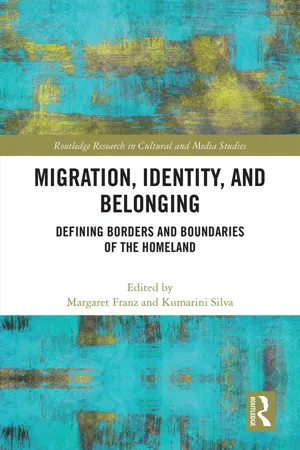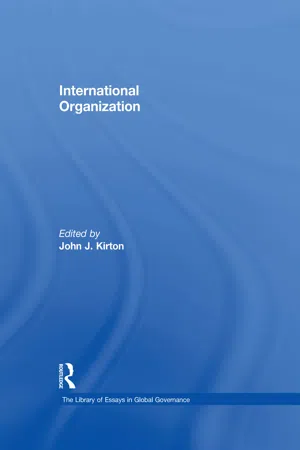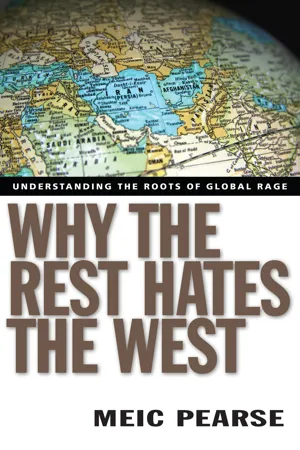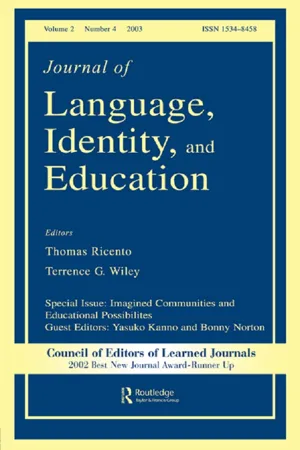Politics & International Relations
Imagined Communities
"Imagined Communities" is a concept introduced by Benedict Anderson, referring to the idea that nations are socially constructed and imagined by the people who perceive themselves as part of a shared community. Anderson argues that the sense of belonging to a nation is not based on direct interactions with all fellow nationals, but rather on a shared understanding and perception of belonging to a larger community.
Written by Perlego with AI-assistance
6 Key excerpts on "Imagined Communities"
Learn about this page
Index pages curate the most relevant extracts from our library of academic textbooks. They’ve been created using an in-house natural language model (NLM), each adding context and meaning to key research topics.
- eBook - ePub
Grounds of Comparison
Around the Work of Benedict Anderson
- Pheng Cheah, Jonathan Culler(Authors)
- 2013(Publication Date)
- Routledge(Publisher)
Chapter 2On Imagined Communities
ERNESTO LACLAUBenedict Anderson’s deservedly famous thesis about the origins and nature of modern nationalism turns around the central notion of an “imagined community.” This category provides him with a matrix out of which one can apprehend—theoretically and historically—the different variants of nationalist discourse formulated over the last two hundred years. We will refer, in the brief comments that follow, to three basic dimensions structuring the fabric of Anderson’s argument: 1) the presuppositions implicit in the notion of an “imagined” community; 2) the kind of substitutability or solidarity which is required to be a member of such a community; 3) the kind of relationship that is established between such a community—which is by definition finite or limited—and its outside. Before that, however, let us describe the main features of Anderson’s thesis.Anderson describes a nation as “an imagined political community—and imagined as both limited and sovereign” (15). It is imagined because most of its members never meet yet nonetheless participate in an “image of their communion.” It is limited because it is not an infinite grouping embracing the totality of humanity—as was the case with the great monotheistic religions—but a definite group of people separated by clear-cut boundaries from other groups. It is sovereign because it has transferred to the State the notion of an illimited power that originally belonged only to God. Finally, it is a community because the nation, “regardless of the actual inequality and exploitation that may prevail in each, the nation is always conceived as a deep, horizontal comradeship” (16).The emergence of the nation as an imagined community can only be explained in terms of the occupation by the nation of the place that originally belonged to other—equally imagined—communities. Anderson points to two of them: the religious community and the dynastic realm. Focusing for a moment on the first—which is the most important—Anderson argues that nationalism inherits from religious types of belonging a deep sense of identification: religion is connected with death, with something we should be able to die for. The tombs of the Unknown Soldier are evoked in this connection. So nationalism would not simply be an ideology, - eBook - ePub
Migration, Identity, and Belonging
Defining Borders and Boundaries of the Homeland
- Margaret Franz, Kumarini Silva, Margaret Franz, Kumarini Silva(Authors)
- 2020(Publication Date)
- Routledge(Publisher)
Once created and transposed to Europe, these early nationalisms “became models which could be emulated in a great variety of social terrains, by a correspondingly wide variety of ideologies.” 8 Writing at a time when nationalism was largely viewed as negative and destructive, Anderson offered a refreshingly different point of view that honed in on the affective ties of the national form. 9 Positing that “regardless of the actual deep inequality and exploitation that may prevail in each, the nation is always conceived as a deep, horizontal comradeship,” 10 Anderson’s main argument—that nationalism solicits such profound attachment because nations are imagined as communities—provided an appealing alternative, a salve even, to think through the increasing evidence that the nation-state was a fragile and violent space. Because Anderson’s publication coincided with an increased academic interest in the impact of globalization, migration, neoliberal economic policies, alongside emerging and established warfare in both the Global North and South, it has, over the years, become the foundation from which conversations of borders and belonging emerge within the academic community. In fact, since its publication in 1983, Imagined Communities has been cited 94,313 times in studies ranging from the construction of the modern social imaginary to the creation of deterritorialized and post-nation-state national attachments. 11 As Pheng Cheah points out, “the connection Anderson posits between the nation-form and imagination is so axiomatic to contemporary academic discourse by now that it scarcely needs to be mentioned.” 12 According to Jonathan Culler, the national imaginaries thesis is a “mantra” in academic discussions of nationalism, possessing the “rightness and efficiency of a classic.” 13 Because of its canonical status, “Imagined Communities” has become a form of shorthand to contextualize relations that infuse Anderson’s argument with a complexity it lacked from inception - eBook - ePub
- John J. Kirton, John J. Kirton(Authors)
- 2017(Publication Date)
- Routledge(Publisher)
Benedict Anderson portrays national ‘homes’ as ‘Imagined Communities’, because ‘the members of even the smallest nation will never know most of their fellow members, meet them, or or even hear of them, yet in the minds of each lives the image of the communion’. 3 As has been confirmed since the end of the Cold War, national ‘Imagined Communities’ are not about to disappear as the basic reality of international life any time soon. Nevertheless, secular changes in technology, economic relations, social epistemes, and institutions are causing globalising and localising pressures that are squeezing the nation-state from both above and below. 4 As a consequence, people have begun to imagine new communities, or ‘homes’. When it comes to their security and well-being, in some parts of the world, growing numbers of people have begun imagining that they share their destiny with people of other nations who share their values and expectations of proper behaviour in domestic and international political affairs. Forty years ago, Karl Deutsch developed the concept of ‘pluralistic security communities’. In this article, I extend this concept by arguing that such communities are socially constructed ‘cognitive regions’ or ‘community-regions’ whose people imagine that, with respect to their own security and economic well-being, borders run, more or less, where shared understandings and common identities end. People who are territorially and politically organised into states, owe their allegiance to states, and act on their behalf, will also take their identity cues from the community region as these communities become more tightly integrated. Further, liberal community-regions, in particular, are more prone to turn into security communities because of shared practical knowledge of peaceful conflict resolution and a propensity to develop strong civil societies and a transnational civic culture - eBook - ePub
Why the Rest Hates the West
Understanding the Roots of Global Rage
- Meic Pearse(Author)
- 2011(Publication Date)
- IVP(Publisher)
6 Imagined Communities
O ne useful coinage of recent years is the expression “Imagined Communities.” It is used mostly by historians of nationalism—or rather, of the development of national consciousness during recent centuries. The term refers to the groups to which people perceive themselves as “belonging.” My “imagined community” is the “we” or “us” of which I instinctively and primarily consider myself to be a part. The others in this “community” need not necessarily be like me in a sense that would satisfy today’s protagonists of identity politics; for they will, at a minimum, include my family, which automatically spans both genders and generations. They will be those with whom I unreflectively (and that is the key word) consider myself, my interests and my destiny to be bound up. They will be those whom I mean when I use an ill-considered we.For premodern people—and for many Third World people even today—the imagined community was the district or region, not the kingdom or state to which the district happened, for the time being, to belong. What kept a premodern state together was the personal authority of its ruler, mediated to his lowliest subjects by a chain of strong, intermediate institutions (i.e., bigger than the individual or family but smaller than the kingdom—that is, as we saw in chapter four, precisely those institutions that modernist political discourse of both right and left has destroyed), mostly centering on personal loyalties. In this way, most states consisted of several—or perhaps many—Imagined Communities.Precisely because premodern states did not—do not—constitute “a people,” most ordinary folk were indifferent as to who was their king. If their province was transferred by treaty or by warfare to the rule of another monarch, the fact made no difference to their lives one way or the other. The ordinary person’s loyalties were, on the microlevel, to locality and its traditions and to particular families. On the macrolevel, they were to the large entity (say, Christendom) to which all such localities as he or she had cognizance of belonged. A thirteenth-century French peasant, forced to identify himself to time-travelers from the early twenty-first century, would have been unlikely to claim to be French or a peasant—though he might possibly have confessed to either of these if pressed by his interrogators. He would describe himself first as a Christian (by which he would mean that he was not a Muslim or a Turk) and second as the subject of such-and-such a local lord, or perhaps as the inhabitant of a particular region. A rural Algerian might do the equivalent even today: first a Muslim, then an inhabitant of a certain village or district. The Russian word for peasant—krest’ian, or “Christian”—tells its own story. As Rich-ard Pipes observes, “The Russian peasant of 1900 owed loyalty only to his own village and canton; at most he was conscious of some vague allegiance to his province. His sense of national identity was confined to respect for the Tsar and suspicion of foreigners.”[1] - eBook - ePub
- Homi K Bhabha(Author)
- 2013(Publication Date)
- Routledge(Publisher)
Imagined Communities significantly paved the way for this book, expresses the nation's ambivalent emergence with great clarity:The century of the Enlightenment, of rationalist secularism, brought with it its own modern darkness. . . . [Few] things were (are) suited to this end better than the idea of nation. If nation states are widely considered to be 'new' and 'historical', the nation states to which they give political expression always loom out of an immemorial past and ... glide into a limitless future. What I am proposing is that Nationalism has to be understood, by aligning it not with self-consciously held political ideologies, but with large cultural systems that preceded it, out of which — as well as against which — it came into being.(19)The nation's 'coming into being' as a system of cultural signification, as the representation of social life rather than the discipline of social polity, emphasizes this instability of knowledge. For instance, the most interesting accounts of the national idea, whether they come from the Tory Right, the Liberal high ground, or the New Left, seem to concur on the ambivalent tension that defines the 'society' of the nation. Michael Oakeshott's 'Character of a modern European state' is perhaps the most brilliant conservative account of the equivocal nature of the modern nation. The national space is, in his view, constituted from competing dispositions of human association as societas (the acknowledgement of moral rules and conventions of conduct) and universitas (the acknowledgement of common purpose and substantive end). In the absence of their merging into a new identity they have survived as competing dogmas - societas cum universitate — 'impos[ing] a particular ambivalence upon all the institutions of a modern state and a specific ambiguity upon its vocabulary of discourse'.1 In Hannah Arendt's view, the society of the nation in the modern world is 'that curiously hybrid realm where private interests assume public significance' and the two realms flow unceasingly and uncertainly into each other 'like waves in the never-ending stream of the life-process itself.2 No less certain is Tom Nairn, in naming the nation 'the modern Janus', that the 'uneven development" of capitalism inscribes both progression and regression, political rationality and irrationality in the very genetic code of the nation. This is a structural fact to which there are no exceptions and 'in this sense, it is an exact (not a rhetorical) statement about nationalism to say that it is by nature ambivalent'.3 - eBook - ePub
Imagined Communities and Educational Possibilities
A Special Issue of the journal of Language, Identity, and Education
- Yasuko Kanno, Bonny Norton, Yasuko Kanno, Bonny Norton(Authors)
- 2012(Publication Date)
- Routledge(Publisher)
2001 ), who make the case that as identities become more hybrid and nation-states increasingly plural, many citizens no longer identify with one imagined community. At the same time, however, Robertson argues that the economic and political divisions of the world have relegated Muslim countries, as well as many developing countries, to secondary status as far as major economic forces are concerned.Rassool (1999 ), similarly, extends Anderson’s work to make the case that transnational centers of power, such as the International Monetary Fund and the World Bank, redefined the concept of national political accountability and extended governance beyond the nation-state. Under these conditions, the will of the people, the individual, and the international community do not necessarily coincide. She argues, however, that one salutary effect of globalization is the free flow of information on the Internet, which can undermine national censorships and create new social movements organized around minority-group interests. As Canagarajah’s (1999 ) research suggests, minority groups such as the Tamils in Sri Lanka have become highly astute at using technology to further struggles for self-determination. Pakistani school children, we argue, are only too aware of their nation’s marginal status in the world, and regard technology as providing crucial access to a larger imagined community.The Study
Zaib and Mohammed are participating in a project begun at a more hopeful time in their school experience. The project, called the Youth Millennium Project (YMP), is a global initiative of the University of British Columbia (UBC), Canada and was motivated by research that suggests youth often feel powerless in the face of global events, believing that they have little contribution to make to social change (see www.ympworld.org





